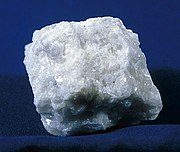
Marble is a nonfoliated metamorphic rock resulting from the metamorphism of limestone, composed mostly of calcite (a crystalline form of calcium carbonate, CaCO3). It is extensively used for sculpture, as a building material, and in many other applications. The word "marble" is colloquially used to refer to many other stones that are capable of taking a high polish.
Etymology
Venus de Milo, front.
The word "marble" derives from the Ancient Greek μάρμαρον (mármaron) or μάρμαρος (mármaros), "crystalline rock", "shining stone", from the verb μαρμαίρω (marmaírō), "to flash, sparkle, gleam". This stem is also the basis for the English word marmoreal, meaning "marble-like."
Origins
Marble is a metamorphic rock resulting from regional or rarely contact metamorphism of sedimentary carbonate rocks, either limestone or dolomite rock, or metamorphism of older marble. This metamorphic process causes a complete recrystallization of the original rock into an interlocking mosaic of calcite, aragonite and/or dolomite crystals. The temperatures and pressures necessary to form marble usually destroy any fossils and sedimentary textures present in the original rock.
Pure white marble is the result of metamorphism of very pure limestones. The characteristic swirls and veins of many colored marble varieties are usually due to various mineral impurities such as clay, silt, sand, iron oxides, or chert which were originally present as grains or layers in the limestone. Green coloration is often due to serpentine resulting from originally high magnesium limestone or dolostone with silica impurities. These various impurities have been mobilized and recrystallized by the intense pressure and heat of the metamorphism.
Construction marble
n the construction, specifically the dimension stone trade, the term "marble" is used for any crystalline calcitic rock (and some non-calcitic rocks) useful as building stone. For example, "Tennessee marble" is really a dense granular fossiliferous gray to pink to maroon Ordovician limestone that geologists call the Holston Formation.
Industrial use
Colorless or light-colored marbles are a very pure source of calcium carbonate, which is used in a wide variety of industries. Finely ground marble or calcium carbonate powder is a component in paper, and in consumer products such as toothpaste, plastics, and paints. Ground calcium carbonate can be made from limestone, chalk, and marble; about three-quarters of the ground calcium carbonate worldwide is made from marble. Ground calcium carbonate is used as a coating pigment for paper because of its high brightness and as a paper filler because it strengthens the sheet and imparts high brightness. Ground calcium carbonate is used in consumer products such as a food additive, in toothpaste, and as an inert filler in pills. It is used in plastics because it imparts stiffness, impact strength, dimensional stability, and thermal conductivity. It is used in paints because it is a good filler and extender, has high brightness, and is weather resistant. However, the growth in demand for ground calcium carbonate in the last decade has mostly been for a coating pigment in paper.
Calcium carbonate can also be reduced under high heat to calcium oxide (also known as "lime"), which has many applications including being a primary component of many forms of cement.
Production
According to the United States Geological Survey, U.S. dimension marble production in 2006 was 46,400 tons valued at $18.1 million, compared to 72,300 tons valued at $18.9 million in 2005. Crushed marble production (for aggregate and industrial uses) in 2006 was 11.8 million tons valued at $116 million, of which 6.5 million tons was finely ground calcium carbonate and the rest was construction aggregate. For comparison, 2005 crushed marble production was 7.76 million tons valued at $58.7 million, of which 4.8 million tons was finely ground calcium carbonate and the rest was construction aggregate. U.S. dimension marble demand is about 1.3 million tons. The DSAN World Demand for (finished) Marble Index has shown a growth of 12% annually for the 2000-2006 period, compared to 10.5% annually for the 2000–2005 period. The largest dimension marble application is tile.
Artificial marble
Faux marble or faux marbling is a wall painting technique that imitates the color patterns of real marble (not to be confused with paper marbling). Marble dust can be combined with cement or synthetic resins to make reconstituted or cultured marble.
Cultural associations
As the favorite medium for Greek and Roman sculptors and architects (see classical sculpture), marble has become a cultural symbol of tradition and refined taste. Its extremely varied and colorful patterns make it a favorite decorative material, and it is often imitated in background patterns for computer displays, etc.
Places named after the stone include Marblehead, Ohio; Marble Arch, London; the Sea of Marmara; India's Marble Rocks; and the towns of Marble, Minnesota; Marble, Colorado; and Marble Hill, Manhattan, New York. The Elgin Marbles are marble sculptures from the Parthenon that are on display in the British Museum. They were brought to Britain by the Earl of Elgin.
From http://en.wikipedia.org/
Ear Force X41 (XBOX LIVE Chat + Wireless Digital RF Game Audio with Dolby
Headphone 7.1 Surround Sound)
-
Ear Force X41 (XBOX LIVE Chat + Wireless Digital RF Game Audio with Dolby
Headphone 7.1 Surround Sound)
by Turtle Beach
[image: Ear Force X41 (XBOX LIVE C...







0 comments:
Post a Comment